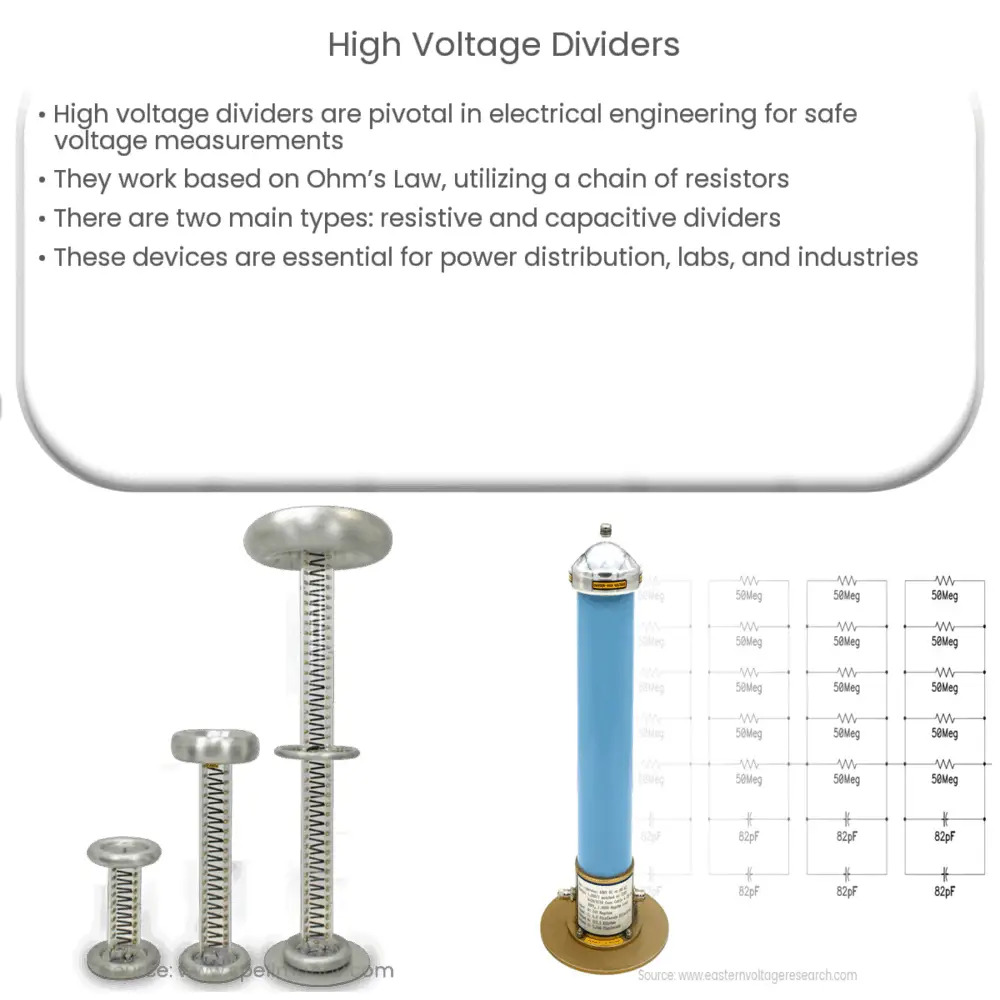“Explore the intricacies of high voltage dividers, their types, applications, and safety measures in this comprehensive guide.

Understanding High Voltage Dividers
A high voltage divider is an essential instrument widely used in the field of electrical engineering. A voltage divider refers to a simple circuit, which turns a large voltage into a smaller one. When dealing with high voltage measurements, these devices play a pivotal role. They help in accurately measuring high voltage levels that are usually unsafe for direct measurement.
The Working Principle of High Voltage Dividers
High voltage dividers operate based on Ohm’s Law and the rules of parallel circuits. They utilize a chain of resistors connected in series. When a high voltage is applied to the series of resistors, it is divided among them, each resistor experiencing a voltage proportional to its resistance.
The voltage is then measured across one of these resistors, and this smaller, safer voltage is used as an indicator of the total voltage across the circuit. The relationship between the total voltage, the voltage across the chosen resistor, and the resistances in the circuit can be defined using Ohm’s law and the formulas for series and parallel resistors.
Types of High Voltage Dividers
There are primarily two types of high voltage dividers: resistive dividers and capacitive dividers.
- Resistive Dividers: These are the most common type of voltage dividers. They are simple to construct, only requiring a series of resistors. However, the choice of resistor values is critical to ensure accurate measurements. They are also temperature-sensitive and must be used within a specified temperature range.
- Capacitive Dividers: Capacitive dividers are more complex than resistive dividers. They employ capacitors rather than resistors to divide the voltage. This kind of divider is used when the frequency of the voltage is significant, as capacitors can handle higher frequencies better than resistors.
Applications of High Voltage Dividers
High voltage dividers have numerous applications in a range of fields. They are used in power distribution networks, in laboratories for experimental purposes, and in industries where electrical power systems are used. By providing a scaled-down version of high voltage, they enable engineers and technicians to work safely and effectively with high voltage systems.
Key Considerations When Using High Voltage Dividers
When utilizing high voltage dividers, certain crucial factors should be taken into account to ensure accurate and reliable measurements. The impedance of the measuring instrument, for example, should match the output impedance of the voltage divider to avoid inaccuracies.
The temperature stability of the divider is another important aspect. As noted earlier, resistive dividers are particularly sensitive to temperature changes, which can impact the accuracy of the measurements. Therefore, ensuring operation within the appropriate temperature range is key.
Advancements in High Voltage Dividers
Technology advancements in the electrical field have led to the development of more sophisticated and reliable high voltage dividers. Modern designs offer enhanced performance characteristics such as better linearity, lower temperature coefficient, and improved long-term stability.
Maintenance of High Voltage Dividers
Like any other equipment, high voltage dividers require regular maintenance and calibration for consistent performance. Routine inspection can help identify signs of wear and tear, contamination, or other anomalies that could affect measurement accuracy.
Understanding Safety Protocols
Due to the high voltage involved, safety is of paramount importance when working with these devices. Users must be fully aware of the potential hazards and ensure that safety protocols are strictly adhered to. This includes using personal protective equipment, implementing safety barriers, and regularly inspecting equipment for any potential risks.
Conclusion
In conclusion, high voltage dividers are integral to many sectors, providing a reliable way to work with high voltage systems. While their application requires thorough understanding and careful operation, advancements in design and material technology continue to enhance their reliability and accuracy. As we continue to rely on high voltage systems, the role of high voltage dividers will undoubtedly remain critical, making understanding these devices key for anyone working in the electrical field.

